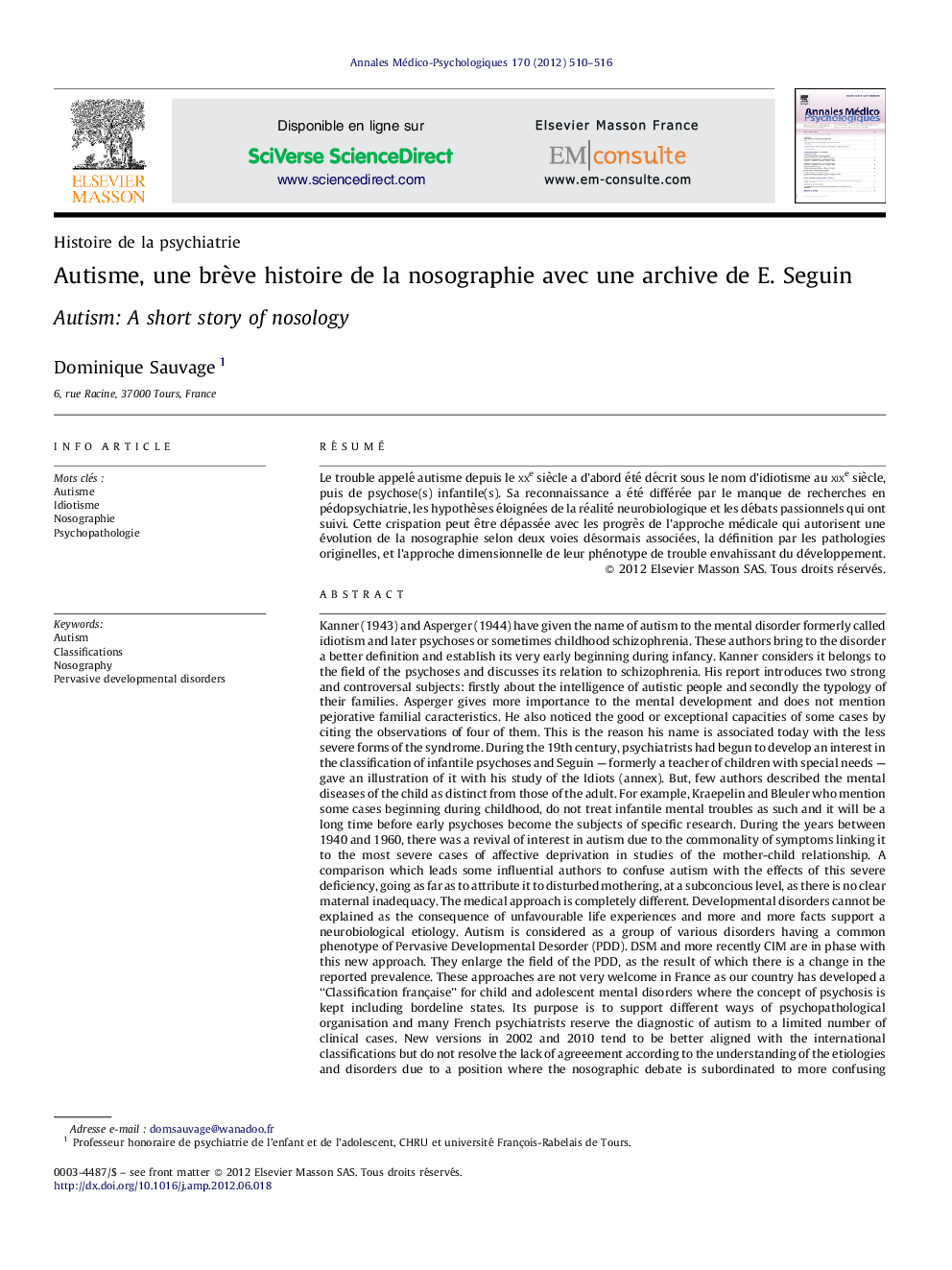| کد مقاله | کد نشریه | سال انتشار | مقاله انگلیسی | نسخه تمام متن |
|---|---|---|---|---|
| 314400 | 534600 | 2012 | 7 صفحه PDF | دانلود رایگان |

RésuméLe trouble appelé autisme depuis le xxe siècle a d’abord été décrit sous le nom d’idiotisme au xixe siècle, puis de psychose(s) infantile(s). Sa reconnaissance a été différée par le manque de recherches en pédopsychiatrie, les hypothèses éloignées de la réalité neurobiologique et les débats passionnels qui ont suivi. Cette crispation peut être dépassée avec les progrès de l’approche médicale qui autorisent une évolution de la nosographie selon deux voies désormais associées, la définition par les pathologies originelles, et l’approche dimensionnelle de leur phénotype de trouble envahissant du développement.
Kanner (1943) and Asperger (1944) have given the name of autism to the mental disorder formerly called idiotism and later psychoses or sometimes childhood schizophrenia. These authors bring to the disorder a better definition and establish its very early beginning during infancy. Kanner considers it belongs to the field of the psychoses and discusses its relation to schizophrenia. His report introduces two strong and controversal subjects: firstly about the intelligence of autistic people and secondly the typology of their families. Asperger gives more importance to the mental development and does not mention pejorative familial caracteristics. He also noticed the good or exceptional capacities of some cases by citing the observations of four of them. This is the reason his name is associated today with the less severe forms of the syndrome. During the 19th century, psychiatrists had begun to develop an interest in the classification of infantile psychoses and Seguin — formerly a teacher of children with special needs — gave an illustration of it with his study of the Idiots (annex). But, few authors described the mental diseases of the child as distinct from those of the adult. For example, Kraepelin and Bleuler who mention some cases beginning during childhood, do not treat infantile mental troubles as such and it will be a long time before early psychoses become the subjects of specific research. During the years between 1940 and 1960, there was a revival of interest in autism due to the commonality of symptoms linking it to the most severe cases of affective deprivation in studies of the mother-child relationship. A comparison which leads some influential authors to confuse autism with the effects of this severe deficiency, going as far as to attribute it to disturbed mothering, at a subconcious level, as there is no clear maternal inadequacy. The medical approach is completely different. Developmental disorders cannot be explained as the consequence of unfavourable life experiences and more and more facts support a neurobiological etiology. Autism is considered as a group of various disorders having a common phenotype of Pervasive Developmental Desorder (PDD). DSM and more recently CIM are in phase with this new approach. They enlarge the field of the PDD, as the result of which there is a change in the reported prevalence. These approaches are not very welcome in France as our country has developed a “Classification française” for child and adolescent mental disorders where the concept of psychosis is kept including bordeline states. Its purpose is to support different ways of psychopathological organisation and many French psychiatrists reserve the diagnostic of autism to a limited number of clinical cases. New versions in 2002 and 2010 tend to be better aligned with the international classifications but do not resolve the lack of agreeement according to the understanding of the etiologies and disorders due to a position where the nosographic debate is subordinated to more confusing psychopathologic considerations. For the future, a “double-diagnostic” for each case may be used (its etiology, its phenotype PDD) together with an increased attention to the dimensional approach of each individual profile, which has become possible as a result of advances in clinical methods.
Journal: Annales Médico-psychologiques, revue psychiatrique - Volume 170, Issue 7, September 2012, Pages 510–516